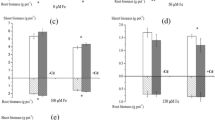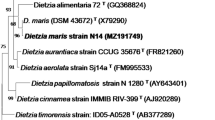Abstract
Antibiotics are released undegraded or partially degraded in the environment which renders them difficult for bioremediation, therefore creating a major threat to antibiotic pollution. Ciprofloxacin (CIP) is a fluoroquinolone that is highly persistent and refractory to degradation. The current study aims to isolate and characterize the CIP resistant, rhizospheric bacteria from Eichhornia crassipes, to assess the effect of root exudates on CIP removal. Also, the plant growth-promoting (PGP) traits of the isolated bacteria were evaluated in the absence and presence of CIP. The enrichment technique in M9 minimal media was used for the isolation and bacteria was identified as Microbacterium sp. WHC1. E.crassipes was able to remove 78% of CIP from Hoagland media. However, the maximum removal was seen in presence of the root exudates and bacterial isolate WHC1 (98%). In-vitro screening of the bacteria was done for studying the PGP traits. Microbacterium sp. WHC1 showed positive results for ammonia and Indole-3-acetic acid (IAA) production, whereas negative results were obtained for hydrogen cyanide (HCN) production and phosphorous (P) solubilization. The current study findings can help in understanding the interactions between the rhizoplane bacteria and root exudates which helps in the decontamination of pollutants. PGP activities of these isolates could be a strategy to improve large scale polluted sites using green and eco-friendly technology.




Similar content being viewed by others
References
Agnello AC, Bagard M, van Hullebusch ED, Esposito G, Huguenot D (2016) Comparative bioremediation of heavy metals and petroleum hydrocarbons co-contaminated soil by natural attenuation, phytoremediation, bioaugmentation, and bioaugmentation-assisted phytoremediation. Sci Total Environ 563:693–703
Agunbiade FO, Olu-Owolabi BI, Adebowale KO (2009) Phytoremediation potential of Eichornia crassipes in metal-contaminated coastal water. Bioresour Technol 100(19):4521–4526
Ahemad M (2014) Remediation of metalliferous soils through the heavy metal resistant plant growth-promoting bacteria: paradigms and prospects. Arab J Chem.
Álvarez A, Yanez ML, Benimeli CS, Amoroso MJ (2012) Maize plants (Zea mays) root exudates enhance lindane removal by native Streptomyces strains. Int Biodeteriorat Biodegrad 66(1):14–18
Amorim CL, Moreira IS, Maia AS, Tiritan ME, Castro PM (2014) Biodegradation of ofloxacin, norfloxacin, and ciprofloxacin as single and mixed substrates by Labrys portucalensis F11. Appl Microbiol Biotechnol 98(7):3181–3190
Baginska E, Haiß A, Kümmerer K (2015) Biodegradation screening of chemicals in an artificial matrix simulating the water-sediment interface. Chemosphere 119:1240–1246
Cordova-Kreylos AL, Scow KM (2007) Effects of ciprofloxacin on salt marsh sediment microbial communities. ISME J 1(7):585
Dhote M, Kumar A, Jajoo A, Juwarkar A (2017) Assessment of hydrocarbon degradation potentials in a plant-microbe interaction system with oil sludge contamination: a sustainable solution. Int J Phytoremed 19(12):1085–1092
Eggleton J, Thomas KV (2004) A review of factors affecting the release and bioavailability of contaminants during sediment disturbance events. Environ Int 30(7):973–980
Gonzalez-Lopez J, Salmeron V, Martinez-Toledo MV, Ballesteros F, Ramos-Cormenzana A (1986) Production of auxins, gibberellins, and cytokinins by Azotobacter vinelandii ATCC 12837 in chemically-defined media and dialyzed soil media. Soil Biol Biochem.
Gordon SA, Weber RP (1951) Colorimetric estimation of indoleacetic acid. Plant Physiol 26(1):192
Guo HG, Gao NY, Chu WH, Li L, Zhang YJ, Gu JS, Gu YL (2013) Photochemical degradation of ciprofloxacin in UV and UV/H 2 O 2 process: kinetics, parameters, and products. Environ Sci Pollut Res 20(5):3202–3213
Hothem SD, Marley KA, Larson RA (2003) Photochemistry in Hoagland’s nutrient solution. J Plant Nutr 26(4):845–854
Hou J, Liu W, Wang B, Wang Q, Luo Y, Franks AE (2015) PGPR enhanced phytoremediation of petroleum-contaminated soil and rhizosphere microbial community response. Chemosphere 138:592–598
James A, Singh DK, Khankhane PJ (2018) Enhanced atrazine removal by hydrophyte–bacterium associations and in vitro screening of the isolates for their plant growth-promoting potential. Int J Phytoremed 20(2):89–97
Jien SH, Lin YH (2018) Proteins in xylem exudates from rapeseed plants (Brassica napus L.) play a crucial role in cadmium phytoremediation. Clean Soil Air Water 46(10):1700164.
Kumar M, Jaiswal S, Sodhi KK, Shree P, Singh DK, Agrawal PK, Shukla P (2019) Antibiotics bioremediation: perspectives on its ecotoxicity and resistance. Environ Int 124:448–461
Laxminarayan R, Duse A, Wattal C, Zaidi AK, Wertheim HF, Sumpradit N, Greko C (2013) Antibiotic resistance—the need for global solutions. Lancet Infect Dis 13(12):1057–1098
Li X, Yang X, Wang N, Xie Y (2015) Potential of Pteris vittata to remove tetracycline antibiotics from aquatic media. Int J Phytoremed 17(9):895–899
Liao X, Li B, Zou R, Dai Y, Xie S, Yuan B (2016) Biodegradation of antibiotic ciprofloxacin: pathways, influential factors, and bacterial community structure. Environ Sci Pollut Res 23(8):7911–7918
Lillenberg M, Litvin SV, Nei L, Roasto M, Sepp K (2010) Enrofloxacin and ciprofloxacin uptake by plants from soil. Agron Res 8(1):807–814
Liu P, Zhang H, Feng Y, Yang F, Zhang J (2014) Removal of trace antibiotics from wastewater: a systematic study of nanofiltration combined with ozone-based advanced oxidation processes. Chem Eng J 240:211–220
Liu W, Hou J, Wang Q, Yang H, Luo Y, Christie P (2015) Collection and analysis of root exudates of Festuca arundinacea L. and their role in facilitating the phytoremediation of petroleum-contaminated soil. Plant and Soil 389(1–2): 109–119.
Lucas WJ, Groover A, Lichtenberger R, Furuta K, Yadav SR, Helariutta Y, Patrick JW (2013) The plant vascular system: evolution, development and functions f. J Integrat Plant Biol 55(4):294–388
Mahar A, Wang P, Ali A, Awasthi MK, Lahori AH, Wang Q, Zhang Z (2016) Challenges and opportunities in the phytoremediation of heavy metals contaminated soils: a review. Ecotoxicol Environ Saf 126:111–121
Malik G, Singh N, Hooda S (2020) Nitrogen stress in plants and the role of phytomicrobiome. In: Phyto-microbiome in stress regulation (pp. 295–322). Springer, Singapore.
Nagpal V, Paknikar KM (2006) Integrated biological approach for the enhanced degradation of lindane.
Olanrewaju OS, Ayangbenro AS, Glick BR, Babalola OO (2019) Plant health: feedback effect of root exudates-rhizobiome interactions. Appl Microbiol Biotechnol 103(3):1155–1166
Oteo J, Saez D, Bautista V, Fernández-Romero S, Hernández-Molina JM, Pérez-Vázquez M, Campos J (2013) Carbapenemase-producing Enterobacteriaceae in Spain in 2012. Antimicrob Agents Chemother 57(12):6344–6347
Polesel F, Andersen HR, Trapp S, Plósz BG (2016) Removal of Antibiotics in biological wastewater treatment system. A critical assessment using the activated sludge modeling framework for xenobiotics (ASM-X). Environ Sci Technol 50(19), 10316–10334.
Premono ME, Moawad AM, Vlek PLG (1996) Effect of phosphate-solubilizing Pseudomonas putida on the growth of maize and its survival in the rhizosphere (No. REP-12113. CIMMYT).
Prieto Rodriguez-Puime A (2019) Effect of the interaction between phytoplankton and bacteria on the response of microbial communities to nutrient inputs (Doctoral dissertation, Ecoloxía e bioloxía animal).
Rajkumar M, Sandhya S, Prasad MNV, Freitas H (2012) Perspectives of plant-associated microbes in heavy metal phytoremediation. Biotechnol Adv 30(6):1562–1574
Rasheed T, Bilal M, Nabeel F, Adeel M, Iqbal HM (2019) Environmentally-related contaminants of high concern: potential sources and analytical modalities for detection, quantification, and treatment. Environ Int 122:52–66
Ribeiro CM, Cardoso EJBN (2012) Isolation, selection and characterization of root-associated growth promoting bacteria in Brazil Pine (Araucaria angustifolia). Microbiol Res 167(2):69–78
Saitou N, Nei M (1987) The neighbor-joining method: a new method for reconstructing phylogenetic trees. Mol Biol Evolut 4(4):406–425
Shah V, Daverey A (2020) Phytoremediation: a multidisciplinary approach to clean up heavy metal contaminated soil. Environ Technol Innov:100774.
Shah A, Hayes CJ, Martin BC (2017) Characteristics of initial prescription episodes and likelihood of long-term opioid use—United States, 2006–2015. MMWR Morb Mortal Week Rep 66(10):265
Singh T, Singh DK (2019) Rhizospheric Microbacterium sp. P27 showing potential of lindane degradation and plant growth promoting traits. Curr Microbiol 76(7), 888–895.
Singh T, Singh DK (2019) Lindane degradation by root epiphytic bacterium Achromobacter sp. strain A3 from Acorus calamus and characterization of associated proteins. Int J Phytoremed 21(5), 419–424.
Sodhi KK, Kumar M, Balan B, Dhaulaniya AS, Singh DK (2019) Isolation and characterization of amoxicillin-resistant bacteria and amoxicillin-induced alteration in its protein profiling and RNA yield. Arch Microbiol:1–8.
Tamura K, Nei M, Kumar S (2004) Prospects for inferring very large phylogenies by using the neighbor-joining method. Proc Natl Acad Sci 101(30):11030–11035
Tiwari D, Bhati P, Das P, Shouch S (2018) Potential of actinomycetes as bioremediating and biocontrolling agents. Int J Biomed Eng 3(2):25–37
Tripathi S, Singh VK, Srivastava P, Singh R, Devi RS, Kumar A, Bhadouria R (2020) Phytoremediation of organic pollutants: current status and future directions. Abatement of Environmental Pollutants (pp. 81–105). Elsevier.
Vejan P, Abdullah R, Khadiran T, Ismail S, Nasrulhaq Boyce A (2016) Role of plant growth promoting rhizobacteria in agricultural sustainability—a review. Molecules 21(5):573
Velpandian T, Halder N, Nath M, Das U, Moksha L, Gowtham L, Batta SP (2018) Un-segregated waste disposal: an alarming threat of antimicrobials in surface and ground water sources in Delhi. Environm Sci Pollut Res 25(29):29518–29528
Wang Q, Zhang W, Li C, Xiao B (2012) Phytoremediation of atrazine by three emergent hydrophytes in a hydroponic system. Water Sci Technol 66(6):1282–1288
Weber T (2014) In silico tools for the analysis of antibiotic biosynthetic pathways. Int J Med Microbiol 304(3–4):230–235
Xiong YW, Li XW, Wang TT, Gong Y, Zhang CM, Xing K, Qin S (2020) Root exudates-driven rhizosphere recruitment of the plant growth-promoting rhizobacterium Bacillus flexus KLBMP 4941 and its growth-promoting effect on the coastal halophyte Limonium sinense under salt stress. Ecotoxicol Environ Saf 194:110374
Yan Y, Xu X, Shi C, Yan W, Zhang L, Wang G (2019) Ecotoxicological effects and accumulation of ciprofloxacin in Eichhornia crassipes under hydroponic conditions. Environ Sci Pollut Res 26(29):30348–30355
Yoon SH, Ha SM, Kwon S, Lim J, Kim Y, Seo H, Chun J (2017) Introducing EzBioCloud: a taxonomically united database of 16S rRNA gene sequences and whole-genome assemblies. Int J Syst Evolut Microbiol 67(5):1
Acknowledgements
Financial assistance provided by the NASF research grant (project entitled “Bioremediation of chemical contaminants and their complexes present in drainage water with high dynamic flux used for irrigation in urban and peri-urban agriculture”), sanction no. NASF/CA-6030/2017-18 is highly acknowledged. KKS highly acknowledges the University Grant Commission (UGC), Government of India for providing the stipend. MK acknowledges the Hindu College, DU for the research grant for the Innovation project (IP-2019-20/SC/06 and 07).
Funding
This study was supported by the funding agency, National Agricultural Science Fund, Indian Council of Agricultural Research, Delhi, India.
Author information
Authors and Affiliations
Corresponding author
Ethics declarations
Conflict of interest
No conflicts of interest.
Research involving human participants and/or animals
The study does not relate to animals or humans.
Additional information
Publisher's Note
Springer Nature remains neutral with regard to jurisdictional claims in published maps and institutional affiliations.
Electronic supplementary material
Below is the link to the electronic supplementary material.
42398_2020_153_MOESM1_ESM.docx
Supplementary Fig. 1: Percentage CIP removal in 14 days by Microbacterium sp. WHC1 on treatment with root exudates. Data (mean & SEM) are representative of three independent experiments. Statistical significance was determined using Student t – test. p <0.05 was considered to be statistically significant (docx 28 kb)
42398_2020_153_MOESM3_ESM.docx
Supplementary Table 2: Plant growth promoting traits of the Microbacterium sp. WHC1 in the presence and absence of CIP (doc 7514 kb)
Rights and permissions
About this article
Cite this article
Sodhi, K.K., Kumar, M., Dhaulaniya, A.S. et al. Enhanced ciprofloxacin removal by plant growth-promoting Microbacterium sp. WHC1 in presence of Eichhornia crassipes root exudates. Environmental Sustainability 4, 143–153 (2021). https://doi.org/10.1007/s42398-020-00153-7
Received:
Revised:
Accepted:
Published:
Issue Date:
DOI: https://doi.org/10.1007/s42398-020-00153-7




